Just as a painter chooses the right brush for a masterpiece, you must select the appropriate saw for your projects. With so many saws available on the market, understanding the types and their uses will empower you to make informed decisions and achieve better results in your woodworking or DIY endeavors.
First, consider the type of project you are undertaking. Are you working on fine woodworking, rough framing, or perhaps making intricate cuts? This question contributes significantly to identifying the right saw. For precision tasks, a handheld coping saw or a jigsaw might serve you well; whereas, larger structural projects may require more heavy-duty options like circular or table saws.
If you are looking for versatility, a circular saw is a great addition to your toolkit. It allows you to make straight cuts through various materials like wood, metals, and plastics. The portability of a circular saw also makes it ideal for working on-site. Pair it with a quality guide rail for even more precision in your cuts.
For those who prioritize safety and ease of use, a miter saw can be the perfect solution. This saw is specialized for making crosscuts and miter cuts, making it an excellent choice for framing and molding projects. You’ll also find that many models include features such as laser guides that enhance cutting accuracy and further boost your confidence in using the tool.
If your projects often involve intricate details, consider investing in a scroll saw. This saw allows you to cut intricate designs and curves with precision, perfect for crafting or fine woodworking projects. It can handle delicate materials, making it a favorite for hobbyists and artisans alike.
Should you need more power for tougher materials or large pieces, a table saw can be a game changer. Table saws are revered for their stability and are perfect for ripping lumber, cutting sheets of plywood, or performing numerous other tasks that require straight cuts. With a variety of available attachments, you can easily expand the capability of this tool.
Additionally, electric saws have advanced significantly, providing options that cater to your comfort and efficiency needs. Consider whether a corded or cordless saw better fits your working environment. Cordless saws offer unmatched convenience, especially when working in remote locations or areas without easy access to power outlets. However, corded options often provide consistent power when working for extended periods.
Finally, don’t overlook the importance of quality and safety features in your saw choice. Investing in a reputable brand may provide better materials and longer-lasting performance. Also, examine safety features such as blade guards and anti-kickback systems, as these features not only protect you but also enhance your overall user experience.
Ultimately, selecting the right saw for your projects is a combination of understanding your needs, the nature of your work, and the features that best suit your style. With this guide, you are now equipped to make informed decisions and take on a variety of projects around your home or workshop with confidence!




